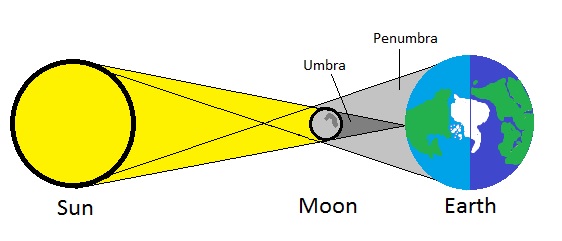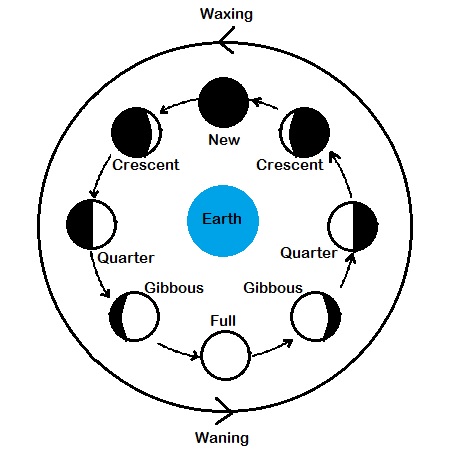Solar Eclipses (High School)
Topic outline
-
Written by: Suzanne Monir, Kimberly Tran, EIS Education Team Members, July 2016
Title: Solar Eclipses
Grade (Age) Level: High School (Ages 14-18), UniversityPre-requisites: Knowledge of space at the grade 9 level is recommended.
This course is to teach students about the solar eclipse phenomenon.-
Forum
-
NASA's official webpage containing information about previous and upcoming solar eclipses.
-
By inputting your city/town, this calculator will let you know when upcoming solar/lunar eclipses will occur.
-
This website by Southern Illinois University has information about upcoming solar eclipses in the United States of America along with a countdown clock until the next eclipse.
-
-
Parts of a Solar Eclipse

Penumbra- The Moon’s faint outer shadow
Umbra- The Moon’s dark inner shadow
Corona- The gaseous envelope of the sun and other stars. The sun’s corona is only visible during a total solar eclipse when it is seen as an irregularly shaped pearly glow surrounded by the darkened disk of the moon
Difference between Solar and Lunar Eclipse
![Lunar vs solar eclipse [Photo Credits UK Mirror]](http://i1.mirror.co.uk/incoming/article5362786.ece/ALTERNATES/s615/Split-Eclipse2.jpg)
Phases of the Moon

The moon has eight phases, with the moon orbiting the Earth once every 29 and a half days. Note, when the illuminated part of the moon is getting bigger, the Moon is waxing. When it is getting smaller, the Moon is waning.
The cycles are as follows:- New Moon: The illuminated side of moon is facing away from the Earth (nothing
is seen)
- Waxing crescent: Less than half of the illuminated side of the Moon is facing
the Earth (right crescent visible)
- First quarter: Half of the illuminated side of the Moon is facing the Earth
(right half visible)
- Waxing gibbous: More than half of the illuminated side of the Moon is facing
the Earth (right side visible)
- Full moon: The illuminated part of the Moon can be fully seen
- Waning gibbous: The illuminated part of the Moon begins to shrink, with more
than half facing the Earth (left side visible)
- Last quarter: The illuminated part of the Moon shrinks, with half facing the
Earth (left half visible)
- Waning crescent: The illuminated part of the Moon shrinks, with less than half facing the Earth (left crescent visible)
- New Moon: The illuminated side of moon is facing away from the Earth (nothing
is seen)
-
A solar eclipse occurs when the moon passes directly between the Sun and the Earth, resulting in a shadow being cast over the Earth. Solar eclipses only occur during the new moon phase and based on alignment, there are four possibly types of solar eclipses that can be seen. This phenomenon lasts a few minutes and on average occurs every 18 months.
Solar eclipses are the product of coincidence. The Sun with a diameter of 1.39 million kilometers is 400 times larger than the moon with a diameter of 3,474 kilometers. However, the moon is roughly 400 times closer to the Earth than the Sun (384,400 km vs 149.6 million km). Something else to note is that the moon has been gradually moving away from the Earth since its formation billions of years ago. At its current distance, the moon is at the perfect position to appear in the sky as the exact same size as the Sun to block it out.In this video by Andy Cohen of TED-Ed, what a solar eclipse is and how it is formed is discussed.
-
Total solar eclipses
![Total solar eclipse [Photo Credit: Earth Sky]](http://en.es-static.us/upl/2015/03/eclipse-total-solar-11-13-2012-NASA.jpg)
These are a happy accident of nature. The sun's 864,000-mile diameter is fully 400 times greater than that of our puny moon, which measures just about 2,160 miles. But the moon also happens to be about 400 times closer to Earth than the sun (the ratio varies as both orbits are elliptical), and as a result, when the orbital planes intersect and the distances align favorably, the new moon can appear to completely blot out the disk of the sun. On the average a total eclipse occurs somewhere on Earth about every 18 months.
There are actually two types of shadows: the umbra is that part of the shadow where all sunlight is blocked out. The umbra takes the shape of a dark, slender cone. It is surrounded by the penumbra, a lighter, funnel-shaped shadow from which sunlight is partially obscured.
During a total solar eclipse, the moon casts its umbra upon Earth's surface; that shadow can sweep a third of the way around the planet in just a few hours. Those who are fortunate enough to be positioned in the direct path of the umbra will see the sun's disk diminish into a crescent as the moon's dark shadow rushes toward them across the landscape.
During the brief period of totality, when the sun is completely covered, the beautiful corona — the tenuous outer atmosphere of the sun — is revealed. Totality may last as long as 7 minutes 31 seconds, though most total eclipses are usually much shorter.
Partial solar eclipses
![Partial [Photo credits: kwwl]](http://kwwl.images.worldnow.com/images/5341428_G.png)
A partial solar eclipse occurs when only the penumbra (the partial shadow) passes over you. In these cases, a part of the sun always remains in view during the eclipse. How much of the sun remains in view depends on the specific circumstances.
Usually the penumbra gives just a glancing blow to our planet over the polar regions; in such cases, places far away from the poles but still within the zone of the penumbra might not see much more than a small scallop of the sun hidden by the moon. In a different scenario, those who are positioned within a couple of thousand miles of the path of a total eclipse will see a partial eclipse.
The closer you are to the path of totality, the greater the solar obscuration. If, for instance, you are positioned just outside of the path of the total eclipse, you will see the sun wane to a narrow crescent, then thicken up again as the shadow passes by.
Annular solar eclipses

An annular eclipse, though a rare and amazing sight, is far different from a total one. The sky will darken but with what appears as twilight also, since so much of the sun still shows. The annular eclipse is a subspecies of a partial eclipse, not total. The maximum duration for an annular eclipse is 12 minutes 30 seconds.
However, an annular solar eclipse is similar to a total eclipse in that the moon appears to pass centrally across the sun. The difference is, the moon is too small to cover the disk of the sun completely. Because the moon circles Earth in an elliptical orbit, its distance from Earth can vary from 221,457 miles to 252,712 miles. But the dark shadow cone of the moon’s umbra can extend out for no longer than 235,700 miles; that’s less than the average distance of the moon from the Earth.
So if the moon is at some greater distance, the tip of the umbra does not reach Earth. During such an eclipse, the antumbra, a theoretical continuation of the umbra, reaches the ground, and anyone situated within it can look up past either side of the umbra and see an annulus, or “ring of fire” around the moon. A good analogy is putting a penny atop a nickel, the penny being the moon, the nickel being the sun.
Hybrid solar eclipses
![Hybrid solar eclipse [Photo Credits: Huffington Post]](http://i.huffpost.com/gen/1436226/images/o-HYBRID-ECLIPSE-facebook.jpg)
These are also called annular-total (“A-T”) eclipses. This special type of eclipse occurs when the moon’s distance is near its limit for the umbra to reach Earth. In most cases, an A-T eclipse starts as an annular eclipse because the tip of the umbra falls just short of making contact with Earth; then it becomes total, because the roundness of the planet reaches up and intercepts the shadow tip near the middle of the path, then finally it returns to annular toward the end of the path.
Because the moon appears to pass directly in front of the sun, total, annular and hybrid eclipses are also called “central” eclipses to distinguish them from eclipses that are merely partial.
Of all solar eclipses, about 28 percent are total; 35 percent are partial; 32 percent annular; and just 5 percent are hybrids.
-
This activity by McGraw Hill Education will allow students to interact with various factors in the formation of solar eclipses.
-
-
You should never view a solar eclipse with unprotected eyes. Staring directly at the Sun can result in retinal burn and blindness. This is because the Sun is too bright for the human eye to handle. During a total eclipse while the Sun is covered by the Moon, it is still dangerous to view unprotected. As a total solar eclipse makes the surrounding area dark, the human pupil dilates to allow more light in for a clearer picture. However the Sun may come out and 'surprise' viewers before they can turn away, making the resulting retinal burn even more dangerous with the eyes trying to let in as much light as possible.
To safely view a solar eclipse, it is important to protect your eyes. The following can be used to safely view a solar eclipse:
* Note- According to NASA, the following materials should never be used to view a solar eclipse:- Sunglasses
- CDs or Computer floppy discs
- Medical x-ray film with images on them
- Colour film
- Smoked glass
Eclipse Glasses

Eclipse glasses can be worn to safely view an eclipse. Check your nearest museum or science center to see if glasses can be bought or rented, otherwise they can be found online for sale.
Welder's Goggles

Welding goggles rated 14 can also be used to safely view a solar eclipse. These goggles contain the darkest lens shade available and can be found at welding supply outlets or online.
Pinhole ProjectorThis video by Videofromspace shows how to make an inexpensive projector
Aluminizied Mylar Sheeting/ Solar filtersAluminized mylar sheeting can be used as a filter to view a solar eclipse. It is easy to cut and attach to a box or viewing device. Alternatively, solar filters can be bought. These filters may be made form aluminized mylar or other material.

- Sunglasses
-
-
In this activity, students will research and share some findings on a solar eclipse that has happened in the past.
-
Quiz
-
Please complete this feedback survey to let us know what you liked about this course and potential areas for improvement.
-
